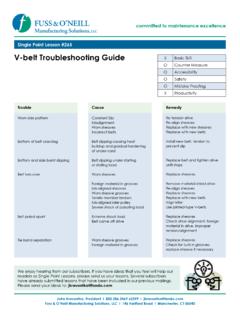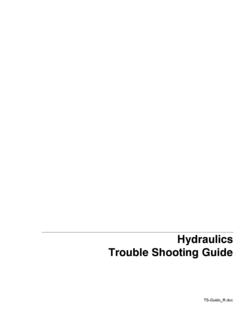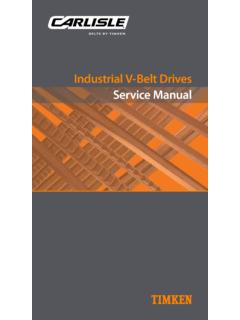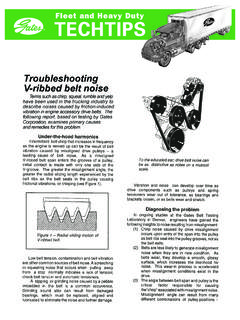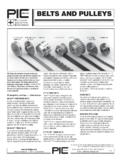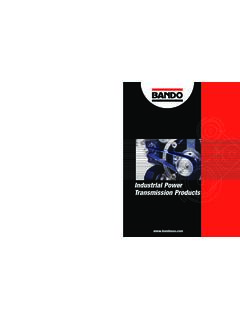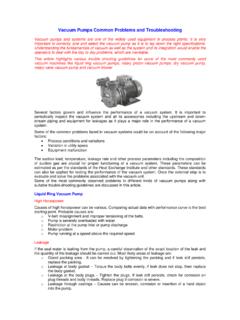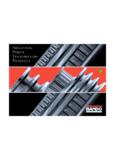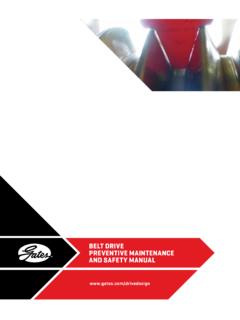Transcription of Vickers General Product Support Hydraulic Hints & Trouble ...
1 694 Revised 8/96 Hydraulic Hints & Trouble Shooting GuideVickers General Product Support2 General Hydraulic Hints3.. troubleshooting guide & Maintenance Hints4.. Chart 1 Excessive Noise5.. Chart 2 Excessive Heat6.. Chart 3 Incorrect Flow7.. Chart 4 Incorrect Pressure8.. Chart 5 Faulty Operation9.. Quiet Hydraulics10.. Contamination Control11.. Hints on Maintenance of Hydraulic Fluid in the System13.. Aeration14.. Leakage Control15.. Hydraulic Fluid and Temperature Recommendations for Industrial Machinery16.. Hydraulic Fluid and Temperature Recommendations for Mobile Hydraulic Systems19.. Oil Viscosity Recommendations20.. Pump Test Procedure for Evaluation of Antiwear Fluids for Mobile Systems21.. Oil Flow Velocity in Tubing 23.. Pipe Sizes and Pressure Ratings24.. Preparation of Pipes, Tubes and Fittings Before Installation in a Hydraulic System25.. ISO/ANSI Basic Symbols for Fluid Power Equipment and Systems26.
2 Conversion Factors29.. Hydraulic Formulas29.. 3 General Hydraulic Hints Good AssemblyPracticesMost important openings in the reservoir should besealed after grinding or welding operationsshould be done in the area wherehydraulic components are cylinder, valve, pump and hoseconnections should be sealed and/orcapped until just prior to spirits should be kept in hoses can be used to clean fittingsand other system components. However,the air supply must be filtered and dry toprevent contamination of the pipe fittings and hoseassemblies prior to use to be certain thatburrs, dirt and/or scale are not pipe and tubing ends should bereamed to prevent restriction andturbulent not use Teflon tape on straightthread installing pumps or motors,always align coupling halves as closelyas possible, within using flexible couplings, follow themanufacturer s recommendations orallow 1/32 to 1/16 inch clearancebetween the coupling not drive couplings on pump ormotor shafts.
3 They should be a slip fit,or shrunk on using hot use a dry spray-on lubricant onsplines when installing. This preventswear and adds to the life of the using double universal jointcouplings, the shafts must be paralleland the yokes must be in installing V- belt pulleys on pumpsor motors, line up both pulleys as closelyas possible. Always install the pulleys witha minimum amount of overhang as closeto the pump or motor face as increases bearing service and steel pipes were the first kindsof plumbing used to conduct fluidbetween system components. Atpresent, pipe is the least expensive wayto go when assembling a steel pipe is recommendedfor use in Hydraulic systems with thepipe interior free of rust, scale and classifications of pipe wallthicknesses were: standard, extra heavyand double extra , pipes are classified by schedulenumber as specified by the AmericanNational Standards Institute (ANSI).
4 Theschedule numbers vary from 10 through160. The larger the number, the heavierthe wall thickness. The outer pipediameter stays the same for a given pipesize, while the inside opening becomessmaller as schedule number comparison of early classificationsversus the ANSI classification follows:Standard Schedule 40 Extra Heavy Schedule 80 The double extra heavy classificationdoes not compare with a schedulenumber. However, the inside diameter ofa double extra heavy pipe isapproximately one half that of a schedule160 many cases, flanges are welded tothe pipe ends and gaskets or O ringsare used to seal the pipe fittings are used to routethe piping to and from each systemcomponent. These fittings can bethreaded or welded in place as the needarises. Threaded connections are usedin low pressure applications and weldedconnections are used if high pressure,high temperature, or a severemechanical load piping should be secured withclamps to prevent vibration andexcessive stress due to the weight ofthe fluid.
5 Do not weld the clamps to thepipe as it may weaken the pipe andcause a stress Do s And Don tsDon t take heavy cuts on thin wall tubingwith a tubing cutter. Use light cuts toprevent deformation of the tube end. Ifthe tube end is out or round, a greaterpossibility of a poor connection tubing only for removal of NOT over ream tubing as it canweaken the not allow chips to accumulate in thetubing. They can be difficult to removeafter the manufacturersrecommendations on the use of flaringtools. Don t overtighten the feed screwhandle on a compression type flaring use of a tool can cause washoutand/or splitting of the flare tubing instead of cutting and usinga fitting. This reduces pressure drop andminimizes system losses. The minimumradius of a tubing bend should be atleast three times the inside diameter ofthe tube. Larger bends are the optimum tubing route beforebeginning the bending process.
6 Be sureto use tubing with the proper temper toprevent wrinkles and flattened flares are made by hand or powertools that swage the tube end over asplit die. The standard flare angle is 37degrees from the centerline. For bestresults, heavy wall tubing should be cut,deburred, and flared and bent usingpower information on sealing technology, orhow to prevent leakage of Hydraulic fluid,refer to Leakage Control in this guide & Maintenance Hints GeneralThe troubleshooting charts andmaintenance Hints that follow are of ageneral system nature but shouldprovide an intuitive feeling for a specificsystem. More General information iscovered in the following and probable cause chartsappear on the following DesignThere is, of course, little point indiscussing the design of a system whichhas been operating satisfactorily for aperiod of time. However, a seeminglyuncomplicated procedure such asrelocating a system or changing acomponent part can cause of this, the following pointsshould be considered:1.
7 Each component in the system mustbe compatible with and form anintegral part of the system. Forexample, an inadequate size filter onthe inlet of a pump can causecavitation and subsequent damage tothe All lines must be of proper size andfree of restrictive bends. Anundersized or restricted line results ina pressure drop in the line Some components must be mountedin a specific position with respect toother components or the lines. Thehousing of an in-line pump, forexample, must remain filled with fluidto provide The inclusion of adequate test pointsfor pressure readings, although notessential for operation, will the SystemProbably the greatest aid totroubleshooting is the confidence ofknowing the system. The construction andoperating characteristics of each oneshould be understood. For example,knowing that a solenoid controlleddirectional valve can be manually actuatedwill save considerable time in isolating adefective solenoid.
8 Some additionalpractices which will increase your abilityand also the useful life of the systemfollow:1. Know the capabilities of the component in the system has amaximum rated speed, torque orpressure. Loading the system beyondthe specifications simply increasesthe possibility of Know the correct operating set and check pressures with agauge. How else can you know if theoperating pressure is above themaximum rating of the components?The question may arise as to what thecorrect operating pressure is. If it isn tcorrectly specified on the hydraulicschematic, the following rule should beapplied:The correct operating pressure is thelowest pressure which will allowadequate performance of the systemfunction and still remain below themaximum rating of the componentsand the correct pressures have beenestablished, note them on the hydraulicschematic for future Know the proper signal levels,feedback levels, and dither and gainsettings in servo control systems.
9 Ifthey aren t specified, check themwhen the system is functioningcorrectly and mark them on theschematic for future SystematicProceduresAnalyze the system and develop alogical sequence for setting valves,mechanical stops, interlocks andelectrical controls. Tracing of flow pathscan often be accomplished by listeningfor flow in the lines or feeling them forwarmth. Develop a cause and effecttroubleshooting guide similar to thecharts appearing on the following initial time spent on such a projectcould save hours of system TroubleIndicationsThe ability to recognize troubleindications in a specific system isusually acquired with , a few General troubleindications can be Excessive heat means Trouble . Amisaligned coupling places anexcessive load on bearings and canbe readily identified by the heatgenerated. A warmer than normaltank return line on a relief valveindicates operation at relief valvesetting.
10 Hydraulic fluids which have alow viscosity will increase the internalleakage of components resulting in aheat rise. Cavitation and slippage in apump will also generate Excessive noise means wear,misalignment, cavitation or air in thefluid. Contaminated fluid can cause arelief valve to stick and chatter. Thesenoises may be the result of dirty filters,or fluid, high fluid viscosity, excessivedrive speed, low reservoir level, looseintake lines or worn simple maintenance procedureshave the greatest effect on hydraulicsystem performance, efficiency and Maintaining a clean sufficient quantityof Hydraulic fluid of the proper typeand Changing filters and Keeping all connections tight, but notto the point of distortion, so that air isexcluded from the following charts are arranged in fivemain categories. The heading of eachone is an effect which indicates amalfunction in the system. For example,if a pump is exceptionally noisy, refer toChart 1 titled Excessive Noise.










